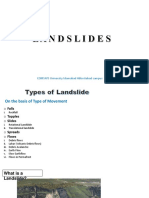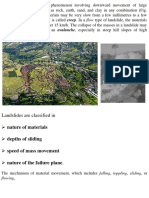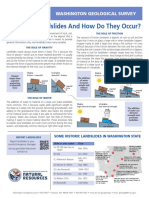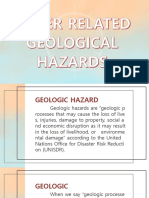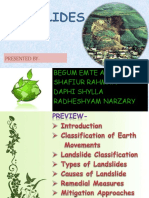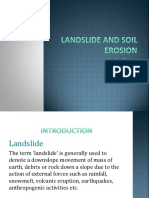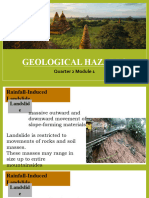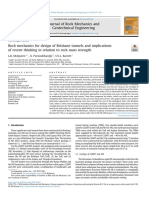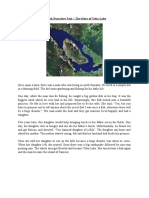0 ratings0% found this document useful (0 votes)
3 viewsLand slides
Landslides are defined as the movement of soil and bedrock due to the rupture of the topographic surface equilibrium, occurring on various types of rock and soil. They can cause significant economic losses and coincide with other natural disasters, resulting in structural damage and landscape changes. Classification of landslides is based on their movement type and material nature, with various causes including gravitational stress, human activities, and environmental factors.
Uploaded by
abeladd2Copyright
© © All Rights Reserved
We take content rights seriously. If you suspect this is your content, claim it here.
Available Formats
Download as PDF, TXT or read online on Scribd
0 ratings0% found this document useful (0 votes)
3 viewsLand slides
Landslides are defined as the movement of soil and bedrock due to the rupture of the topographic surface equilibrium, occurring on various types of rock and soil. They can cause significant economic losses and coincide with other natural disasters, resulting in structural damage and landscape changes. Classification of landslides is based on their movement type and material nature, with various causes including gravitational stress, human activities, and environmental factors.
Uploaded by
abeladd2Copyright
© © All Rights Reserved
We take content rights seriously. If you suspect this is your content, claim it here.
Available Formats
Download as PDF, TXT or read online on Scribd
You are on page 1/ 26
(I)LANDSLIDES
•In general, defined as the product of the rupture in the
topographic surface equilibrium
•The terms slope movement or failure and landslide when
used in a generic sense are generally equivalent in meaning
•Landslides can occur on any type of rock and soil
•result in a movement of soil and bedrock
•may be responsible of the main morphological features of
the landscape
¾The size of landslides
•variable from detachments of a few cubic meters to
movement of hundreds of millions of cubic meter
• Landslides inflict economic losses and casualties in
many areas and on a frequent basis
• often, they coincide with other natural disasters such
as earthquakes, floods, or volcanic eruptions.
• One of the most obvious damage caused by Landslides
i by
is b tilting,
tilti shearing,
h i and
d pulling
lli apartt off rockk and
d
soils
• Thus resulting in damage to structures
constructed of rock or soil and to those made of
non‐earth
non earth materials placed on a foundation of
soil or rock
¾Examples damages by landslides
• Road p pavements warped p and cracked byy
landslide movement
• The blockingg of roads byy landslide debris
• buildings remain fully unfunctional and safe
after their foundation is sheared by landslide
movement
• Damming of streams by landslides can result in
later catastrophic flooding
¾ Clasificationoflandslides
I based
I. b d on both b h their
h i genetic
i and
d morphologic
h l i ffeatures,
II. on the basis of the type of movement and nature of the
materials being displaced
• A landslide involves vertical and horizontal movement of
soil rock,
soil, rock or some combination of the two under the
influence of gravity. These slope movements are usually
categorized as:
• Falls
• topples
• slides
• spreads
• flows.
Type of movement Type of material
Bed rock Predominantly Predominantly fine
coarse
fall Rock fall Debris fall Earth fall
topple Rock topple Debris topple Earth topple
R k slump
Rock l D b i slump
Debris l E th slump
Earth l
Rock block slide Debris block slide Earth block slide
slides
Rock slide Debris slide Earth slide
Lateral spreads Rock spread Debris spread Earth spread
Flow Rock flow Debris flow Earth flow
complex Deep creep Soil creep
¾ a soil fall or a rock fall
• when the rocky material falls from almost vertical or
very steep slopes and the material moves without a
continuous contact with the slope and then collapses,
jump and rolls down.
¾Sliding
• when an earth mass moves along a well
defined shear surface and the detached
material moves in an apparently unitary
movement.
• Sliding….
Slidi
• The shear surface may be planar (more
common)) or concave
• Planar‐In this case it is referred as a slide
• Concave‐in
C i this
hi case iti is
i referred
f d as a slump
l (
(or
rotational landslide. Slumps are characterized
by an upward concave shear surface and by the
fact that the sliding material maintains some
compactness
p
¾flows (earth flows, debris flows, mud flows,
etc.).
• ‐when the material slides like a viscous mass
• events are typically a direct consequence of
rainfalls of extreme intensity
¾soil creep
• Soil creep is a particular process such that
some stratified rocks, like clay, slate, grit etc.,
have their layer margins bent in a down slope
direction
• The process of creeping may largely affect
slope stability as well as produce a pushing
action on retaining walls or other engineering
structures
¾Evidence of soil creep
• Terracettes
• down slope tilting of poles,
• curving down slope of trees
• soil accumulation on the uphill side of retaining
walls
¾Some of the causes of soil creep are:
• Alternation of heating and cooling phases in the
soil
• Swelling
ll and d shrinkage
h k in surface
f rocks
k
• Growth of ice wedges
• Alternation of aridity and humidity conditions in
the soil
• Animall bburrowing activity, and
• Earthquake shocks
¾ Featuresusedfor therecognitionoflandslides
• Landslides can be active or inactive
• There are certain features used for identification of
l d lid iin the
landslides h fi field ld
I) Activelandslides
• Scarps and fractures possess sharp edges and open mode
without secondary filling
• Main units show secondary fracture and pressure ridges
• Surfaces show polishing and striations, fresh appearance
• Deranged drainage and ponds
• No soil development and only fast‐growing vegetation
• Considerable distinction between slide and non‐slide areas
in form
form, roughness
roughness, texture and vegetation cover
• Tilted vegetation and poles.
• a)Insedimentsor loosedeposits
• Transverse
T ridges
id att the
th head;
h d longitudinal
l it di l
ridges in track and concentric ridges at the toe
runningg transverse to morphology
p gy
• Transverse and radial fractures at toe; radial
shears at margins and crevasse‐style cracking
over breaks
b k off slope
l
• Spreading at toe; valleys partially or wholly
blocked and rivers diverted
• Materials locally derived but displaced below
outcrop.
p Materials mayy include blocks of intact
rock and stratigraphy can be repeated down
slope.
II)Inactivelandslides
• Scarps and fractures weathered and indistinct, cracks
infilled
• No secondary failures of pressure ridges (often subdued)
• Surfaces weathered, vegetated
• Integrated drainage but may have irregular pattern and
sudden infilled depressions.
• Soil cover and well vegetated or cultivated
• Difficult to distinguish margins and textures except on air
photographs
h h
• New growth on trees and vertical growth of post‐slide
trees
¾ Causesoflandslides
• the decreased ability of a slope to resist
gravitational influence
• an increased effectiveness of gravity acting on the
slope
• a combination of these two elements
• the nature of the bedrock or soil present
p g p y, vegetation,
• topography, g , and climate
• either increasing stress or decreasing material
strength
¾ In many instances the principal cause of the slide
cannot be removed, so it may be more economical to
alleviate the effects
1. Factorsthatcontributetoincreasedshear stress
2. Removal of lateral support
3. Previous rock fall, slide, subsidence, or large‐scale
faulting that creates new slopes.
4. Work of human agencies
5. Surcharge
6. Transitory earth stresses
7. Regional tilting
8. Removal of underlying support
9. Lateral pressure
• Examples:
I) Removal of lateral support
• Streams and rivers, which produce most natural
slopes that are subject to Sliding
• Glaciers, which have deeply cut and over‐
steepened many valley mountainous regions that
have been the sites of large slides and debris
flows.
flows
• Waves and long shore or tidal currents
• Subarial
S b i l weathering,
th i wetting
tti and d drying,
d i and d
frost action.
• Work of human agencies
• Cuts, quarries, pits and canals are established,
• Retaining and sheet piling are removed, and
• Lakes and reservoirs are created and their levels
altered
• Surcharge
• Weight of rain, hail, snow and water from springs
• Accumulation of talus overriding landslide materials
• Collapse of accumulated volcanic material, producing
avalanches and debris flows
• Vegetation
• Seepage pressures of percolating water
• Transitory earth stresses
• Vibrations resulting from earth quakes, blasting
machinery, traffic, thunder, and adjacent slope failures
• Regional tilting
• progressive increase in the slope angle through
regional tilting caused by underground mining
• Removal of underlying support
• undercutting of banks by rivers and by waves
• Subarial weathering,g, wettingg and drying,
y g, and
frost action
• Subterranean erosion in which soluble material,
such as carbonates, salt, or gypsum is removed.
• Mining and similar actions by human agencies
• Loss of strength or failure in underlying
material
• Squeezing out of underlying plastic material
• Lateral pressure
• Water in cracks and caverns,
• Freezing of water in cracks
cracks,
• Swelling as a result of hydration of clay or
anhydrite
• Mitigating the effects of landslide processes
• land‐use planning
• to use zoning
o go of relative
e at e landslide
a ds de hazard
a a d to aavoid
od
placing residences, commercial buildings, or
g
critical facilities in higher hazard areas(grading
g g
ordinances )
• Changing
g g the ggeometryy of the Landslip
p
• Drainage
• to add reinforcement by driving piles through
landslide material into the stable material below
the shear zone at the bottom of the slide
• material is placed on the toe of the landslide to help
resist moments Promoting sliding.
• Ground anchorages
• The design of remedial works for unstable rock slopes
¾ procedures
You might also like
- Geomorphology a Canadian perspective 4th Edition Alan S. Trenhaile 2024 Scribd Download100% (5)Geomorphology a Canadian perspective 4th Edition Alan S. Trenhaile 2024 Scribd Download51 pages
- Australian Standard: Methods For Sampling and Testing Aggregates Part 0: List of MethodsNo ratings yetAustralian Standard: Methods For Sampling and Testing Aggregates Part 0: List of Methods6 pages
- Landslides - Definition, Causes and Types TuritoNo ratings yetLandslides - Definition, Causes and Types Turito1 page
- Neotectonics is the study of recent geological processesNo ratings yetNeotectonics is the study of recent geological processes55 pages
- Disaster Readiness and Risk Reduction: Quarter 2week 1No ratings yetDisaster Readiness and Risk Reduction: Quarter 2week 131 pages
- CHAPTER 6other Related Geological HazardsNo ratings yetCHAPTER 6other Related Geological Hazards7 pages
- Types of Landslides: Ministry of Lands AND Mineral ResourcesNo ratings yetTypes of Landslides: Ministry of Lands AND Mineral Resources2 pages
- Chapter 4 Highway Maintenance and RehabilitationNo ratings yetChapter 4 Highway Maintenance and Rehabilitation86 pages
- Chapter 15 Geology and Nonrenewable Mineral Resources PowerPointNo ratings yetChapter 15 Geology and Nonrenewable Mineral Resources PowerPoint63 pages
- The Effect of Earth Plate Shifts On QiblaNo ratings yetThe Effect of Earth Plate Shifts On Qibla8 pages
- Bertrand-Sarfati, 1995, Geology, First Ediacaran Fauna Found in Western Africa and Evidence For An Early Cambrian GlaciationNo ratings yetBertrand-Sarfati, 1995, Geology, First Ediacaran Fauna Found in Western Africa and Evidence For An Early Cambrian Glaciation15 pages
- Rock Mechanics For Design of Brisbane Tunnels An - 2019 - Journal of Rock MechanNo ratings yetRock Mechanics For Design of Brisbane Tunnels An - 2019 - Journal of Rock Mechan8 pages
- Exploration of Leadzinc PBZN Mineralization Using Very Low Frequencyelectromanetic Vlfem in Ishiagu Ebonyi State 2329 6755 1000214No ratings yetExploration of Leadzinc PBZN Mineralization Using Very Low Frequencyelectromanetic Vlfem in Ishiagu Ebonyi State 2329 6755 10002147 pages
- Plate Tectonics Steve Tomecek pdf download100% (1)Plate Tectonics Steve Tomecek pdf download54 pages
- Chapter 5: Environmental Cycles and ProcessesNo ratings yetChapter 5: Environmental Cycles and Processes6 pages
- Contoh Narrative Text - The Story of Toba LakeNo ratings yetContoh Narrative Text - The Story of Toba Lake4 pages
- HISTORY of ARCHY. (Arc 232) 2nd Semester Note-1No ratings yetHISTORY of ARCHY. (Arc 232) 2nd Semester Note-12 pages
- Optimum Drill and Blast An Ever Changing TargetNo ratings yetOptimum Drill and Blast An Ever Changing Target13 pages
- 53M-BD-INF-STA-DWG-EHF-945-T10(GRANITE-IL)No ratings yet53M-BD-INF-STA-DWG-EHF-945-T10(GRANITE-IL)1 page
- UNESCO World Heritage Site: The Lower Valley of The AwashNo ratings yetUNESCO World Heritage Site: The Lower Valley of The Awash24 pages
- Third Form Students Course Outline - Geography Semseter 1 2020 - 2021No ratings yetThird Form Students Course Outline - Geography Semseter 1 2020 - 202112 pages
- Operational Update - Mengo-Kundji-Bindi (MKB), Republic of Congo (Brazzaville)No ratings yetOperational Update - Mengo-Kundji-Bindi (MKB), Republic of Congo (Brazzaville)1 page
- A New Species of Pachyrhinosaurus CeratoNo ratings yetA New Species of Pachyrhinosaurus Cerato254 pages









